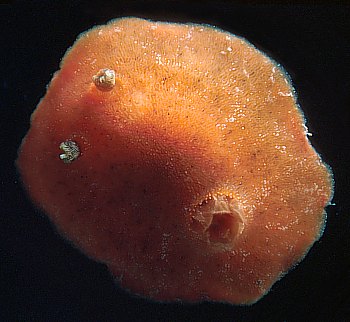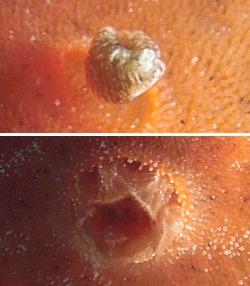

Rostanga orientalis
Rudman & Avern, 1989
Order: NUDIBRANCHIA
Suborder: DORIDINA
Superfamily: EUDORIDOIDEA
Family: Dorididae
DISTRIBUTION
Known at present from Japan and China.
PHOTO
Hoi Ha (Flynn Pt.), Hong Kong; 1-4m, (27 mm long preserved), 18 April 1983, AM C139144. Photos: Brian Darvell.
See also R. orientalis - Radula.
The colour photographs show the animal to be reddish orange with small scattered brown specks on the mantle epithelium. There are also scattered white specks mainly restricted to the tips of the caryophyllidia. The rhinophore stalk is transparent and the club is a translucent brown with some white edging to the vertical lamellae especially at the upper end. The stalked knob is white. The gills are translucent orange with some white speckling and a thin marginal or perhaps slightly sub-marginal white line at the tip of each gill. The animal is typical for the genus with the ovate mantle having a dense covering of caryophyllidia. The gills form an upright circle and each gill has a noticeably flattened tip. The rhinophore club consists of almost vertical lamellae and is surmounted by a stalked knob in the posterior mid-line. An egg mass, probably of this species, is illustrated by Abe (1964). It is a broad ribbon, somewhat sinuous along the free edge. This broad thin type of egg ribbon with apparently very small eggs is indicative of planktotrophic larvae.
Although some references to species of Rostanga from Japan refer to this species, the lack of anatomical detail, especially rhinophore and radular morphology, make identification difficult. The earliest record of R. orientalis from Japan is probably Eliot's record of R. muscula (1913), on the basis of radular morphology. Baba (1935) gives a good description of the radula and rhinophore morphology of this species (as R. muscula), and later references to R. arbutus (Baba, 1937, 1949; Abe, 1964) from Japan presumably refer to R. orientalis. There are no external features separating R. orientalis from other red species with vertical lamellae on the rhinophore. It differs from other described species of Rostanga in having a very elongate innermost lateral tooth with many short inner denticles and in having relatively large jaw plates. The name orientalis refers to its known distribution in Japan and China.
References:
• Rudman, W.B. & Avern, G.J. (1989). The genus Rostanga Bergh, 1879 (Nudibranchia:
Dorididae) in the Indo-West Pacific. Zoological Journal of the Linnean Society 96: 281-338.
Rudman, W.B., 2002 (February 4) Rostanga orientalis Rudman & Avern, 1989. [In] Sea Slug Forum. Australian Museum, Sydney. Available from http://www.seaslugforum.net/factsheet/rostorie
Related messages
-
Rostanga orientalis from the Yellow Sea
From: Dong Bum Koh, August 19, 2006 -
Rostanga orientalis from Hong Kong
From: Bill Rudman & Brian Darvell, February 8, 2002
